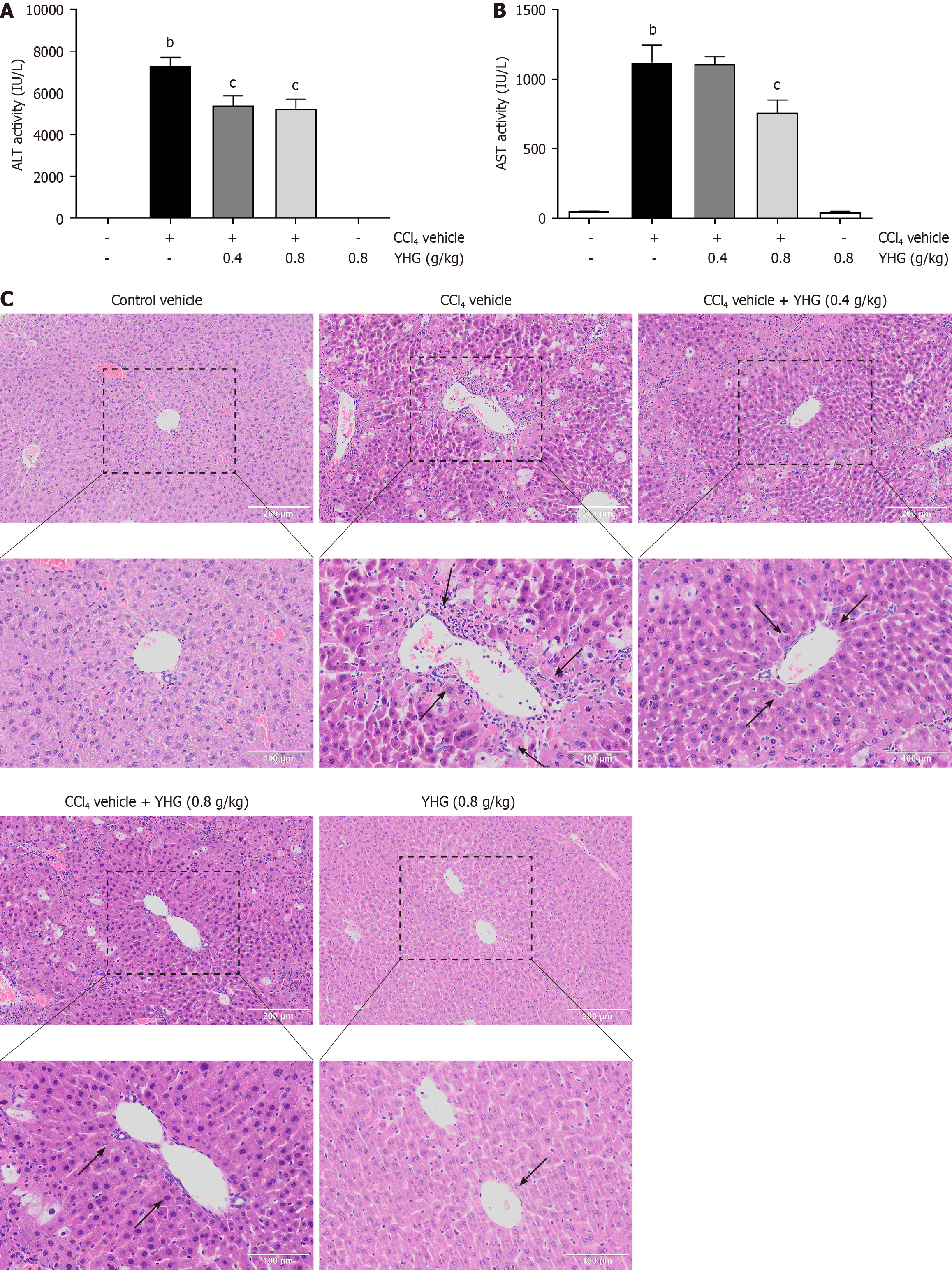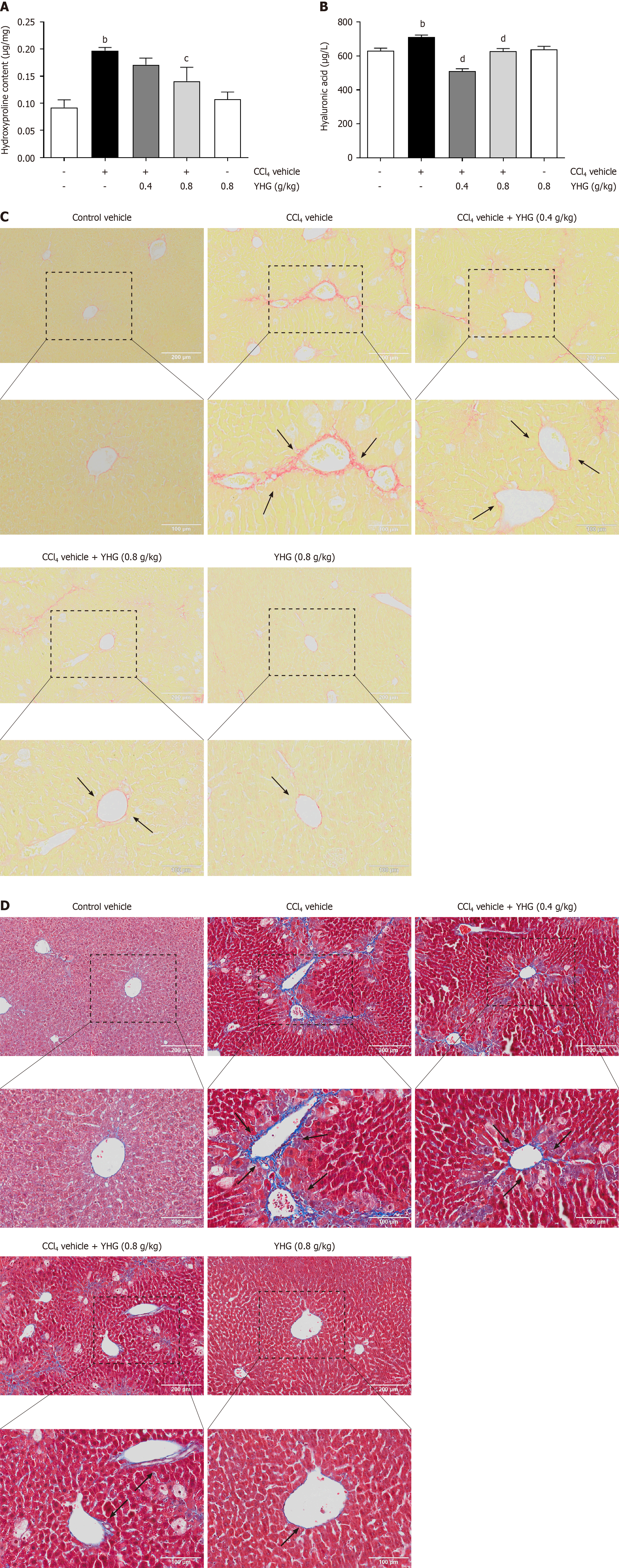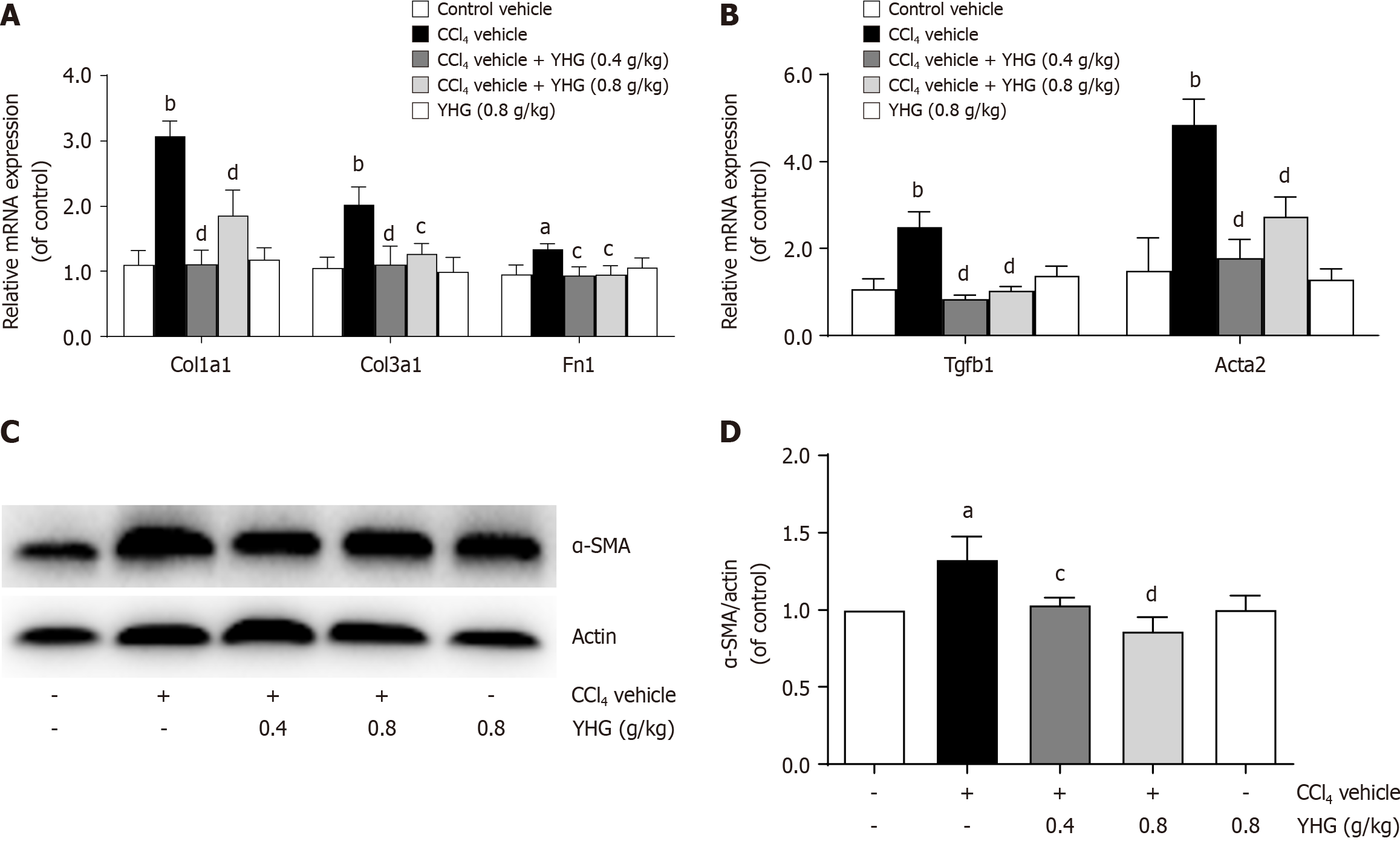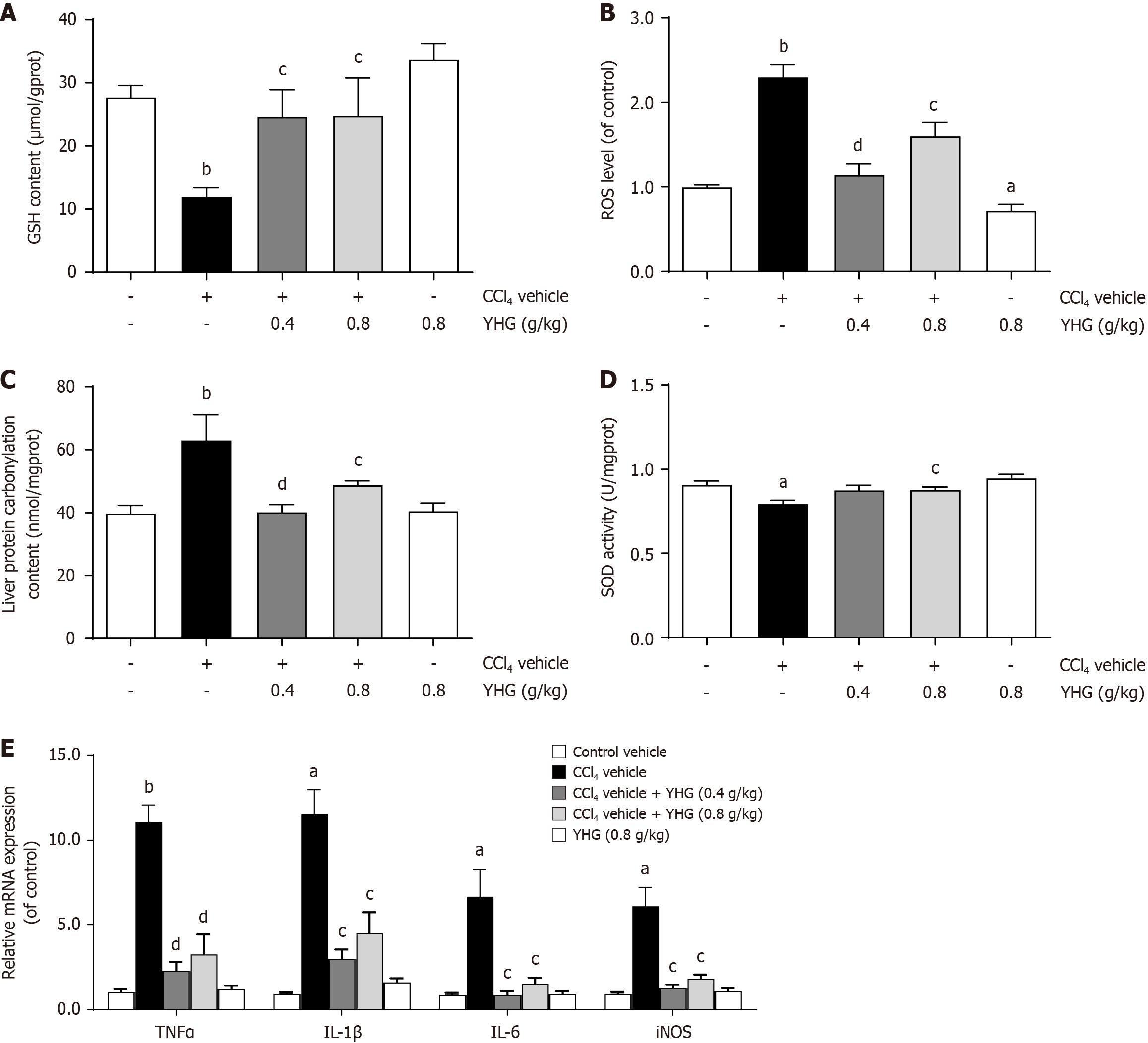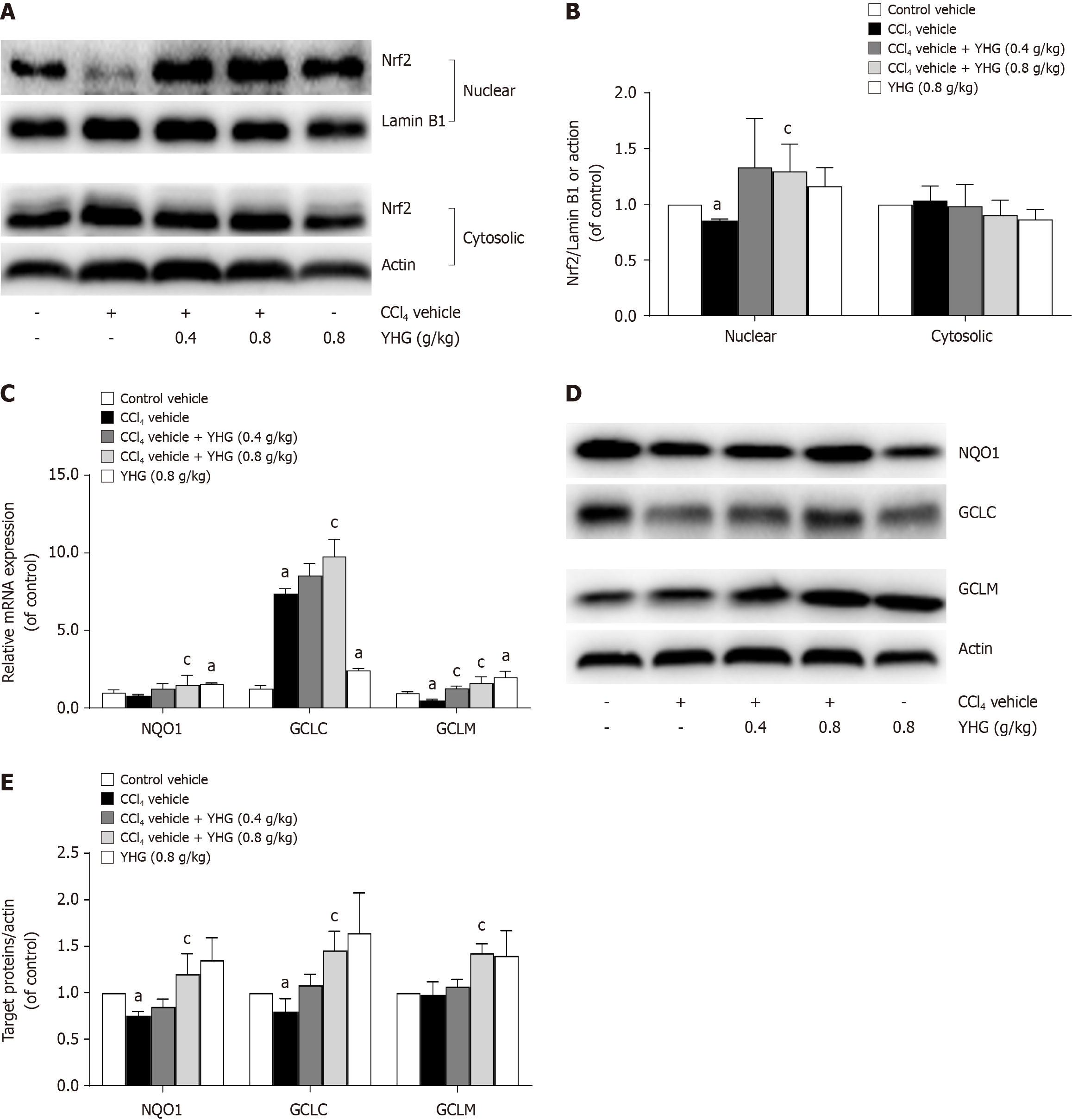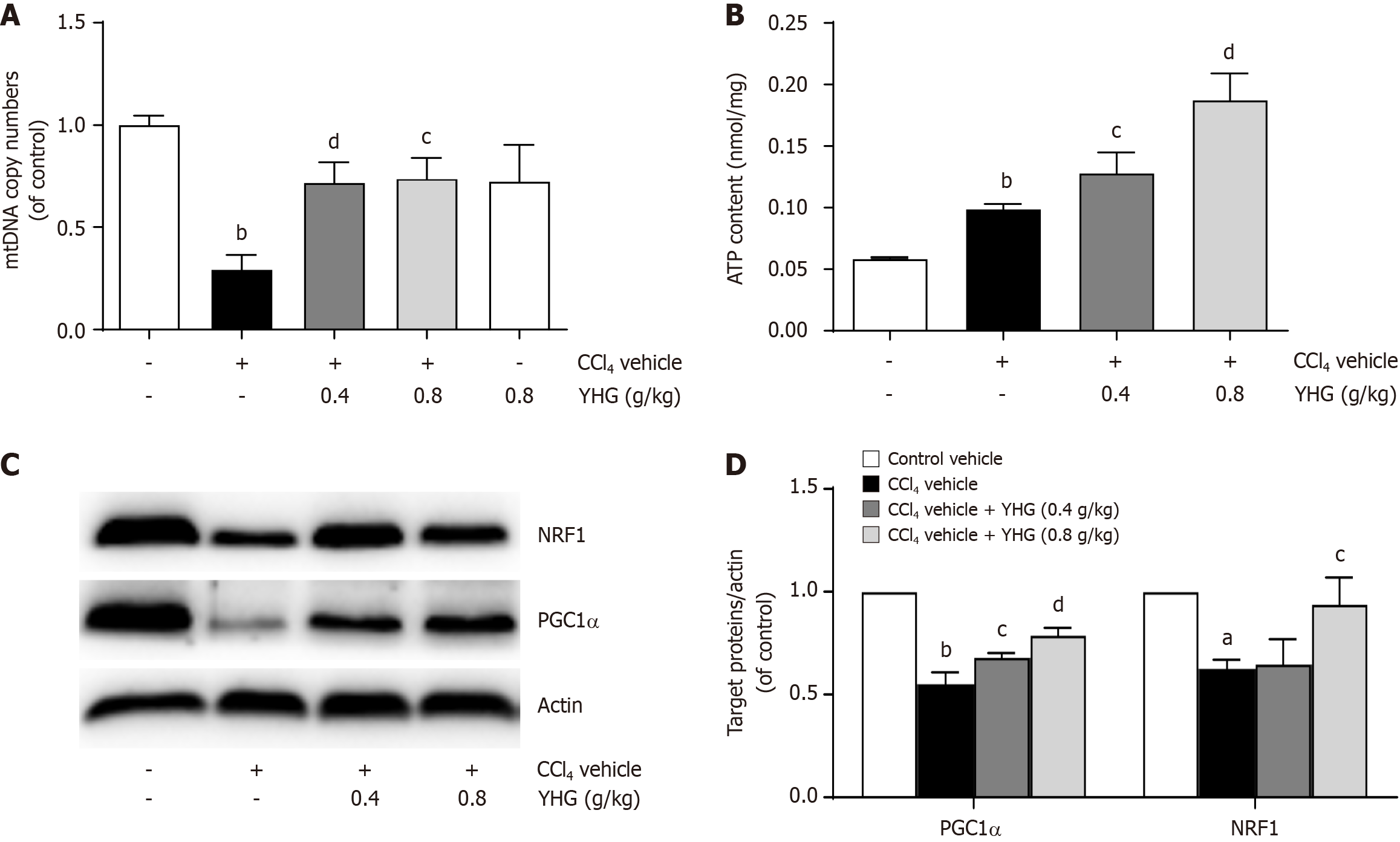Copyright
©The Author(s) 2024.
World J Hepatol. Feb 27, 2024; 16(2): 264-278
Published online Feb 27, 2024. doi: 10.4254/wjh.v16.i2.264
Published online Feb 27, 2024. doi: 10.4254/wjh.v16.i2.264
Figure 1 Effects of Yinhuang granule on serum activities of alanine/aspartate aminotransferase and liver histological evaluation.
A: Serum alanine aminotransferase activity; B: Serum aspartate aminotransferase activity; C: Liver H&E staining. Arrows indicate hepatic infiltration of immune cells, swelling and necrosis of hepatocytes. Typical images were chosen from each experimental group. (Original magnification ×100, upper images; partial enlarged pictures, down images). Data are expressed as mean ± SEM (n = 5). bP < 0.01 vs control vehicle; cP < 0.05 vs CCl4 vehicle. CCl4: Carbon tetrachloride. ALT: Alanine aminotransferase; AST: Aspartate aminotransferase.
Figure 2 Yinhuang granule decreased liver hydroxyproline content and hepatic collagen expression in carbon tetrachloride-treated mice.
A: Liver hydroxyproline content (n = 6); B: Serum content of hyaluronic acid (n = 6); C: Liver Masson's trichrome staining. Arrows indicate collagen disposition; D: Liver Sirius red staining. Arrows indicate collagen disposition. (Original magnification ×100, upper images; partial enlarged pictures, down images). Data were expressed as mean ± SEM. bP < 0.01 vs control vehicle; cP < 0.05, dP < 0.01 vs carbon tetrachloride vehicle. CCl4: Carbon tetrachloride; YHG: Yinhuang granule.
Figure 3 Yinhuang granule decreased hepatic stellate cells activation in carbon tetrachloride-treated mice.
A: Hepatic mRNA expression of Col1a1, Col3a1 and Fn1 (n = 5-6); B: Hepatic mRNA expression of Tgfb1 [transforming growth factor (TGF)-β] and Acta2 [α-smooth muscle actin (α-SMA)] (n = 6); C: The expression of liver α-SMA protein was detected by Western blot, and β-actin was used as a loading control. The results represent four independent experiments; D: The protein bands of α-SMA were normalized to basal β-actin expression (n = 4). Data were expressed as mean ± SEM. aP < 0.05, bP < 0.01 vs control vehicle; cP < 0.05, dP < 0.01 vs carbon tetrachloride vehicle. CCl4: Carbon tetrachloride; YHG: Yinhuang granule.
Figure 4 Yinhuang granule ameliorated hepatic oxidative stress damage and inflammation induced by carbon tetrachloride in mice.
A: Liver glutathione content (n = 6); B: Liver reactive oxygen species level (n = 6); C: Liver protein carbonylation content (n = 6); D: Liver superoxide dismutase activity (n = 5); E: Hepatic mRNA expression of tumour necrosis factor alpha, interleukin (IL)-1b, IL-6 and inducible nitric oxide synthase (n = 4-5). Data were expressed as mean ± SEM. aP < 0.05, bP < 0.01 vs control vehicle; cP < 0.05, dP < 0.01 vs carbon tetrachloride vehicle. CCl4: Carbon tetrachloride; YHG: Yinhuang granule; GSH: Liver glutathione; ROS: Reactive oxygen species; SOD: Superoxide dismutase; TNF: Tumour necrosis factor; IL: Interleukin; iNOS: Inducible nitric oxide synthase.
Figure 5 Yinhuang granule induced the activation of hepatic nuclear factor erythroid 2-related factor 2 antioxidant signaling pathway in carbon tetrachloride-treated mice.
A: The expression of liver hepatic nuclear factor erythroid 2-related factor 2 (Nrf2) was detected by Western blot, and b-actin and Lamin B1 were used as loading controls. The results represent at least three independent experiments; B: The protein bands of Nrf2 were normalized to basal b-actin or Lamin B1 expression (n = 3-4); C: Hepatic mRNA expression of NAD(P)H:quinone oxidoreductase-1 (NQO1), glutamate-cysteine ligase (GCLC) and modifier subunit of glutamate-cysteine ligase (GCLM) (n = 3); D: The expression of liver NQO1, GCLC and GCLM was detected by Western blot, and b-actin was used as a loading control. The results represent at least three independent experiments; E: The protein bands of NQO1, GCLC and GCLM were normalized to basal b-actin expression (n = 3-4). Data were expressed as mean ± SEM. aP < 0.05 vs control vehicle; cP < 0.05 vs carbon tetrachloride vehicle. CCl4: Carbon tetrachloride; YHG: Yinhuang granule; Nrf2: Nuclear factor erythroid 2-related factor 2; NQO1: NAD(P)H:quinone oxidoreductase 1; GCLC: Glutamate-cysteine ligase; GCLM: Glutamate-cysteine ligase.
Figure 6 Yinhuang granule induced mitochondrial biogenesis in carbon tetrachloride-treated mice.
A: Liver mitochondrial DNA (mtDNA) copy numbers (n = 5); B: Liver adenosine triphosphate level (n = 5); C: The expression of liver peroxisome proliferator-activated receptor gamma coactivator 1 alpha (PGC1α) and nuclear respiratory factor 1 (NRF1) was detected by Western blot, and b-actin was used as a loading control. The results represent three independent experiments; D: The protein bands of PGC1a and NRF1 were normalized to basal b-actin expression (n = 3). Data were expressed as mean ± SEM. aP < 0.05, bP < 0.01 vs control vehicle; cP < 0.05, dP < 0.01 vs carbon tetrachloride vehicle. ATP: Adenosine triphosphate; CCl4: Carbon tetrachloride; YHG: Yinhuang granule; PGC1α: Proliferator-activated receptor gamma coactivator 1 alpha; NRF1: Nuclear respiratory factor 1.
- Citation: Ouyang H, Miao H, Li Z, Wu D, Gao SC, Dai YY, Gao XD, Chai HS, Hu WY, Zhu JF. Yinhuang granule alleviates carbon tetrachloride-induced liver fibrosis in mice and its mechanism. World J Hepatol 2024; 16(2): 264-278
- URL: https://www.wjgnet.com/1948-5182/full/v16/i2/264.htm
- DOI: https://dx.doi.org/10.4254/wjh.v16.i2.264









